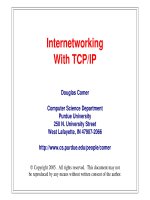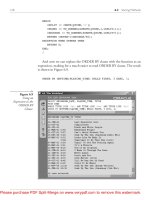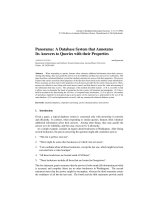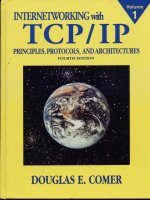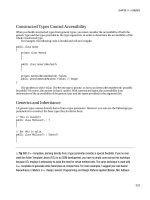Internetworking with TCP/IP- P4 potx
Bạn đang xem bản rút gọn của tài liệu. Xem và tải ngay bản đầy đủ của tài liệu tại đây (595.31 KB, 10 trang )
Preface
xxix
pressive (many industries recruit graduates from the course). Although such experimen-
tation is safest when the instructional laboratory network is isolated from production
computing facilities, we have found that students exhibit the most enthusiasm, and
benefit the most, when they have access to a functional
TCP/IP internet.
The book is organized into four main parts. Chapters
1
and
2
foml an introduction
that provides
an
overview and discusses existing network technologies. In particular,
Chapter
2
reviews physical network hardware. The intention is to provide basic intui-
tion about what is possible, not to spend inordinate time on hardware details. Chapters
3-13
describe the TCP/IP Internet from the viewpoint of a single host, showing the pro-
tocols a host contains and how they operate. They cover the basics of Internet address-
ing and routing as well as the notion of protocol layering. Chapters
14-20
and
32
describe the architecture of an internet when viewed globally. They explore routing
ar-
chitecture and the protocols routers use to exchange routing information. Finally,
Chapters
21-31
discuss application level services available in the Internet. They present
the client-server model of interaction, and give several examples of client and server
software.
The chapters have been organized bottom up. They begin with an overview of
hardware and continue to build new functionality on top of it. This view will appeal to
anyone who has developed Internet software because it follows the same pattern one
uses in implementation. The concept of layering does not appear until Chapter
11.
The
discussion of layering emphasizes the distinction between conceptual layers of func-
tionality and the reality of layered protocol software in which multiple objects appear at
each layer.
A
modest background is required to understand the material. The reader is expect-
ed to have a basic understanding of computer systems, and to
be
familiar with data
structures like stacks, queues, and trees. Readers need basic intuition about the organi-
zation of computer software into an operating system that supports concurrent
prograrn-
ming and application programs that users invoke to perform computation. Readers do
not need sophisticated mathematics, nor do they need to know
infom~ation theory or
theorems from data communications; the book describes the physical network as a black
box around which an internetwork can
be
built. It states design principles clearly, and
discusses motivations and consequences.
I
thank
all
the people who have contributed to versions of this book. Michael
Evangelista provided extensive assistance with this edition, including classifying RFCs.
Jeff Case provided the SNMPv3 example. John Lin and Dennis Totin commented on
some of the new chapters. Jin Zhang, Kechiun He, and Sara Steinbrueck proofread
parts of the text. Special thanks go to my wife and partner, Chris, whose careful editing
made many improvements throughout.
Douglas
E.
Comer
January,
2000
What Others Have Said About The Fourth
Edition Of Internetworking With
TCPIIP
"This is the book
I
go to for clear explanantions of the basic principles and la-
test developments in TCPAP technologies. It's a 'must have' reference for
networking professionals.
"
Dr. Ralph Droms
Professor at Bucknell University
"When the Nobel committee turns its attention to the Internet, Doug gets the
prize for literature. This is an updated classic that is the best way to master
Internet technology.
"
Dr. Paul V. Mockapetris
Inventor of the Domain Name System
"The best-written TCPAP book
I
have ever read.
Dr.
Comer explains complex
ideas clearly, with excellent diagrams and explanations."
Dr. John Lin,
Bell Laboratories
"Comer continues to prove himself the Baedeker of the Internet Protocols with
this fine
4th edition."
Dr. Vinton Cerf
Senior Vice president, MCI WorldCom
"There are many TCP/IP books on the shelves today, but Doug Comer's 'Inter-
networking with TCPAP' is the one that comes
off
the shelf for accessible and
authoritative answers to questions about Internet technology."
Dr. Lyman Chapin,
Chief Scientist, BBN Technologies
Other Books In the Internetworking Series
from Douglas Comer and Prentice
Hall
Internetworking With TCP/IP Volume
11:
Design, Implementation, and
Internals (with David Stevens),
3rd edition: 1999, ISBN 0-13-973843-6
Volume I1 continues the discussion of Volume I by using code from a running im-
plementation of TCP/IP to illustrate all the details. The text shows, for example, how
TCP's slow start algorithm interacts with the Partridge-Kam exponential retransmission
backoff algorithm and how routing updates interact with datagram forwarding.
Internetworking With TCP/IP Volume 111: Client-Server Programming
and Applications (with David Stevens)
BSD Socket Version, 2nd edition: 1996, ISBN 0-13-260969-X
AT&T
TLI Version: 1994, ISBN 0-13-474230-3
Windows Sockets Version: 19!l7, ISBN 0-13-848714-6
Volume
III
describes the fundamental concept of client-server computing used to
build all distributed computing systems. The text discusses various server designs as
well as the tools and techniques used to build clients and servers, including Remote
Procedure Call
(RPC).
It contains examples of running programs that illustrate each of
the designs and tools. Three versions of Volume
111
are available for the socket
API
(Unix),
the TLI API (AT&T System V), and the Windows Sockets
API
(Microsoft).
Computer Networks And Internets (with a CD-ROM
by
Ralph Droms),
2nd
edition:
1999,
ISBN 0-13-083617-6
A
broad introduction to data communication, networking, internetworking, and
client-server applications,
Computer Networks
And
Internets
examines the hardware and
software components that make up computer networks, from the lowest levels through
applications. The text covers transmission and modems, LANs and LAN extensions,
access technologies,
WANs, protocols (including TCPAP), and network applications.
The CD-ROM features animations and data sets.
The Internet Book: Everything you need to know about computer network-
ing and how the Internet works,
2nd edition:
1997,
ISBN 0-13-890161-9,
paperback
A gentle introduction to networking and the Internet,
The Internet Book
does not
assume the reader has a technical background. It explains the Internet, how it works,
and services available in general terms, without focusing on a particular computer or a
particular brand of software. Ideal for someone who wants to become Internet and
computer networking literate,
The Internet Book
explains the terminology as well as the
concepts; an extensive glossary of terms and abbreviations is included.
To
order, visit the Prentice
Hall
Web page at www.prenhall.com/
or contact your local bookstore or Prentice Hall representative.
In North America, call 1-515-284-6751, or send a
FAX
to 1-515-284-6719.
Introduction And Overview
1
.I
The Motivation For Internetworking
Internet communication has become a fundamental part of life. The World Wide
Web contains information about such diverse subjects
as
atmospheric conditions, crop
production, stock prices, and airline traffic. Groups establish electronic mailing lists so
they can share information of common interest. Professional colleagues exchange busi-
ness correspondence electronically, and relatives exchange personal greetings.
Unfortunately, most network technologies are designed for a specific purpose.
Each enterprise chooses hardware technology appropriate for specific communication
needs and budget. More important, it is impossible to engineer a universal network
from a single network technology because no single network suffices for all uses. Some
groups need high-speed networks to connect computers in a single building. Low-cost
technologies that fill the need cannot span large geographic distances. Other groups set-
tle for a slower speed network that connects machines thousands of miles apart.
For over two decades, a new technology has evolved that makes it possible to in-
terconnect many disparate physical networks and make them function
as
a coordinated
unit. The technology, called
internetworking,
accommodates multiple, diverse underly-
ing hardware technologies by providing a way to interconnect heterogeneous networks
and a set of communication conventions that makes them interoperate. The internet
technology hides the details of network hardware, and permits computers to communi-
cate independent of their physical network connections.
The internet technology described in this book is an example of
open system inter-
connection.
It is called
open
because, unlike proprietary communication systems avail-
able from one specific vendor, the specifications are publicly available. Thus, anyone
can build the software needed to communicate across an internet. More important, the
entire technology has been designed to foster communication among machines with
2
Introduction
And
Overview Chap.
1
diverse hardware architectures, to use almost any packet switched network hardware, to
accommodate a wide variety of applications, and to accommodate multiple computer
operating systems.
To appreciate internet technology, think of how it has changed business. In addi-
tion to high-speed communication among employees
in
the office environment, net-
working technologies provide instant feedback among the production side of the busi-
ness, sales and marketing, and customers. As a result, the speed with which business
can plan, implement, assess, and retool has increased; the change is dramatic.
1.2
The
TCPAP
Internet
U.S.
government agencies realized the importance and potential of internet technol-
ogy many years ago, and have funded research that has made possible a global Internet.
This book discusses principles and ideas underlying the internet technology that has
resulted from research funded by the
Advanced Research Projects Agency (ARPA)j
The ARPA technology includes a set of network standards that specify the details of
how computers communicate, as well as a set of conventions for interconnecting net-
works and routing traffic. Officially named the
TCPm
Internet Protocol Suite and
commonly referred to as
TCPAP
(after the names of its two main standards), it can be
used to communicate across any set of interconnected networks. For example, some
corporations use
TCPlIP
to interconnect all networks within their corporation, even
though the corporation has no connection to outside networks. Other groups use
TCP/IP
for communication among geographically distant sites.
Although the
TCP/IP
technology is noteworthy by itself, it is especially interesting
because its viability has been demonstrated on a large scale. It forms the base technolo-
gy for the global Internet that connects over
170
million individuals in homes, schools,
corporations, and government labs in virtually all populated countries. In the
US,
The
National Science Foundation (NSF),
the
Department of Energy (DOE),
the
Department
of Defense (DOD),
the
Health and Human Services Agency (HHS),
and the
National
Aeronautics and Space Administration (NASA)
have all participated in funding the Inter-
net, and use
TCPILP
to connect many of their research sites. Known as the
ARPANSF
Internet,
the
TCP/IP Internet,
the
global Internet,
or just the
Internee,
the resulting
communication system allows subscribers to share information with anyone around the
world
as
easily as they share it with someone in the next room.
An
outstanding suc-
cess, the Internet demonstrates the viability of the
TCP/IP
technology and shows how it
can accommodate a wide variety of underlying network technologies.
Most of the material in this book applies to any internet that uses
TCPm,
but
some chapters refer specifically to the global Internet. Readers interested only in the
technology should be careful to watch for the distinction between the Internet architec-
ture
as
it exists and general
TCPlIP
internets as they might exist. It would
be
a mis-
take, however, to ignore all sections of the text that describe the global Internet
-
many corporate networks are already more complex than the global Internet of a dozen
tAt various times,
ARPA
was called the
Defense Advanced Research Projects Agency (DARPA).
$We will follow the usual convention of capitalizing
Internet
when referring specifically to the global
Internet,
and
use lower case to refer to private internets that use
TCPm
technology.
Sec.
1.2
The
TCPlIP
Internet
3
years ago, and many of the problems they face have already been solved
in
the global
Internet.
1.3
lnternet Services
One cannot appreciate the technical details underlying
TCPm
without understand-
ing the services it provides. This section reviews internet services briefly, highlighting
the services most users access, and leaves to later chapters the discussion of how com-
puters connect to a
TCPDP
internet and how the functionality is implemented.
Much of our discussion of services will focus on standards called
protocols.
Proto-
cols like
TCP
and
IP
provide the syntactic and semantic rules for communication. They
contain the details of message formats, describe how a computer responds when a mes-
sage arrives, and specify how a computer handles errors or other
abnornlal conditions.
Most important, they allow us to discuss computer communication independent of any
particular vendor's network hardware. In a sense, protocols are to communication what
algorithms are to computation.
An
algorithm allows one to specify or understand a
computation without knowing the details of a particular
CPU
instruction set. Similarly,
a communication protocol allows one to specify or understand data communication
without depending on detailed knowledge of a particular vendor's network hardware.
Hiding the low-level details of communication helps improve productivity in
several ways. First, because programmers deal with higher-level protocol abstractions,
they do not need to learn or remember as many details about a given hardware confi-
guration. Thus, they can create new programs quickly. Second, because programs built
using higher-level abstractions are not restricted to a particular computer architecture or
a particular network hardware, they do not need to be changed when computers or net-
works are replaced or
reconfigured. Third, because application programs built using
higher-level protocols are independent of the underlying hardware, they can provide
direct communication between an arbitrary pair of computers. Programmers do not
need to build a special version of application software for each type of computer or
each type of network. Instead, software built to use protocols is general-purpose; the
same code can
be
compiled and run on an arbitrary computer.
We will see that the details of each service available on the Internet are given by a
separate protocol. The next sections refer to protocols that specify some of the
application-level services as well
as
those used to define network-level services. Later
chapters explain each of these protocols in detail.
1.3.1
Application Level lnternet Services
From the user's point of view, the Internet appears to consist of a set of application
programs that use the underlying network to carry out useful communication tasks. We
use the
tern1
interoperability
to refer to the ability of diverse computing systems to
cooperate in solving computational problems. Internet application programs exhibit a
high degree of interoperability. Most users that access the Internet do so merely by run-
4
Introduction
And
Overview
Chap.
1
ning application programs without understanding the types of computers being accessed,
the TCP/IP technology, the structure of the underlying internet, or even the path the
data travels to its destination; they rely on the application programs and the underlying
network software to handle such details. Only programmers who write network applica-
tion programs need to view a
TCP/IP internet as a network and need to understand
some of the technology.
The most popular and widespread Internet application services include:
World Wide Web.
The Web allows users to view documents that contain text and
graphics, and to follow hypermedia links from one document to another. The
Web grew to become the largest source of traffic on the global Internet between
1994
and
1995,
and continues to dominate. Some service providers estimate that
the Web now accounts for
80%
of their Internet traffic.
Electronic mail (e-mail).
Electronic mail allows a user to compose
a
memo and
send a copy to individuals or groups. Another part of the mail application allows
users to read memos that they have received.
A
recent innovation allows users to
include "attachments" with a mail message that consist of arbitrary files. Elec-
tronic mail has been so successful that many Internet users depend on it for most
correspondence. One reason for the popularity of Internet e-mail arises from a
careful design: the protocol makes delivery reliable. Not only does the mail sys-
tem on the sender's computer contact the mail system on the receiver's computer
directly, but the protocol specifies that a message cannot be deleted by the sender
until the receiver has successfully placed a copy on permanent storage.
File transfer.
The file transfer application allows users to send or receive a copy
of a data file. File transfer is one of the oldest, and still among the most heavily
used application services in the Internet. Although small files can now be at-
tached to an e-mail message, the file transfer service is still needed to handle arbi-
trarily large files. The system provides a way to check for authorized users, or
even to prevent
all
access. Like mail, file transfer across a TCPAP internet is reli-
able because the two machines involved communicate directly, without relying on
intermediate machines to make copies of the file along the way.
Remote login.
Remote login allows a user sitting at one computer to connect to a
remote machine and establish an interactive login session. The remote login
makes it appear that a window on the user's screen connects directly to the remote
machine by sending each keystroke from the user's keyboard to the remote
machine and displaying each character the remote computer prints in the user's
window. When the remote login session terminates, the application returns the
user to the local system.
We will return to these and other applications in later chapters to examine them in more
detail. We will see exactly how they use the underlying TCPAP protocols, and why
having standards for application protocols has helped ensure that they are widespread.
Sec.
1.3
Internet Services
5
1.3.2
Network-Level Internet
Services
A
programmer who creates application programs that use TCP/IP protocols has an
entirely different view of an internet than a user who merely executes applications like
electronic mail.
At
the network level, an internet provides two broad types of service
that all application programs use. While it is unimportant at this time to understand the
details of these services, they cannot be omitted from any overview of TCPm
Connectionless Packet Delivery Service.
This service, explained in detail
throughout the text, forms the basis for
all
other internet services. Connectionless
delivery is an abstraction of the service that most packet-switching networks offer.
It means simply that a TCPAP internet routes small messages from one computer
to another based on address information camed in the message. Because the con-
nectionless service routes each packet separately, it does not guarantee reliable,
in-order delivery. Because it usually maps directly onto the underlying hardware,
the connectionless service is extremely efficient. More important, having
connec-
tionless packet delivery as the basis for all internet services makes the TCPLP
protocols adaptable to a wide range of network hardware.
Reliable Stream Transport Service.
Most applications
need
much more than
packet delivery because they require the communication software to recover au-
tomatically from transmission errors, lost packets, or failures of intermediate
switches along the path between sender and receiver. The reliable transport ser-
vice handles such problems. It allows an application on one computer to establish
a "connection" with an application on another computer, and then to send a large
volume of data across the connection as
if
it were a permanent, direct hardware
connection. Underneath, of course, the communication protocols divide the
stream of data into small messages and send them, one at a time, waiting for the
receiver to acknowledge reception.
Many networks provide basic services similar to those outlined above, so one
might wonder what distinguishes TCP/IP services from others. The primary distin-
guishing features are:
Network Technology Independence.
Although TCPm is based on conventional
packet switching technology, it is independent of any particular vendor's
hardware. The global Internet includes a variety of network technologies ranging
from networks designed to operate within a single building to those designed to
span large distances.
TCPm protocols define the unit of data transmission, called
a
datagram,
and
specify
how to transmit datagrams on a particular network.
Universal Interconnection.
A
TCP/IP internet allows any pair of computers to
which it attaches to communicate. Each computer is assigned an
address
that is
universally recognized throughout the internet. Every datagram carries the ad-
dresses of its source and destination. Intermediate switching computers use the
destination address to make routing decisions.
Introduction
And
Overview
Chap.
1
End-to-End Acknowledgements. The TCP/IP internet protocols provide ack-
nowledgements between the original source and ultimate destination instead of
between successive machines along the path, even if the source and destination do
not connect to a common physical network.
Application Protocol Standarch. In addition to the basic transport-level services
(like reliable stream connections), the TCP/IP protocols include standards for
many common applications including electronic mail, file transfer, and remote lo-
gin. Thus, when designing application programs that use
TCPIIP, programmers
often find that existing software provides the communication services they need.
Later chapters will discuss the details of the services provided to the programmer as
well as many of the application protocol standards.
1.4
History And Scope
Of
The Internet
Part of what makes the
TCP/IP
technology so exciting is its universal adoption as
well as the size and growth rate of the global Internet. ARPA began working toward an
internet technology in the mid 1970s, with the architecture and protocols taking their
current form around 1977-79. At that time, ARPA was known as the primary funding
agency for packet-switched network research and had pioneered many ideas
in
packet-
switching with its well-known ARPANET. The ARPANET used conventional point-to-
point leased line interconnection, but ARPA had also funded exploration of packet-
switching over radio networks and satellite communication channels. Indeed, the grow-
ing diversity of network hardware technologies helped force ARPA to study network in-
terconnection, and pushed internetworking forward.
The availability of research funding from ARPA caught the attention and imagina-
tion of several research groups, especially those researchers who had previous experi-
ence using packet switching on the
ARPANET.
ARPA
scheduled informal meetings of
researchers to share ideas and discuss results of experiments. Informally, the group was
known
as
the Internet Research Group. By 1979, so many researchers were involved in
the TCPLP effort that ARPA created an informal committee to coordinate and guide the
design of the protocols and architecture of the emerging Internet. Called the Internet
Control and Configuration Board (ICCB), the group met regularly until 1983, when it
was reorganized.
The global Internet began around 1980 when ARPA started converting machines
attached to its research networks to the new
TCP/IP protocols. The ARPANET, already
in place, quickly became the backbone of the new Internet and was used for many of
the early experiments with TCPLP. The transition to Internet technology became com-
plete
in
January 1983 when the Office of the Secretary of Defense mandated that all
computers connected to long-haul networks use TCPLP. At the same time, the Defense
Communication Agency (DCA) split the ARPANET into two separate networks, one for
further research and one for military communication. The research part retained the
name ARPANET; the military part, which was somewhat larger, became known as the
military network, MILNET.
Sec.
1.4
History And Scope Of The Internet
7
To encourage university researchers to adopt and use the new protocols, ARPA
made an implementation available at low cost. At that time, most university computer
science departments were running a version of the
UNIX
operating system available in
the University of California's
Berkeley Sofnyare Distribution,
commonly called
Berke-
ley UNIX
or
BSD UNIX.
By funding Bolt Beranek and Newman, Incorporated
(BBN)
to
implement its TCP/IP protocols for use with UNIX and funding Berkeley to integrate
the protocols with its software distribution, ARPA was able to reach over 90% of
university computer science departments. The new protocol software came at a particu-
larly significant time because many departments were just acquiring second or third
computers and connecting them together with local area networks. The departments
needed communication protocols.
The Berkeley software distribution became popular because it offered more than
basic TCP/IP protocols. In addition to standard TCPm application programs, Berkeley
offered a set of utilities for network services that resembled the UNIX services used on
a single machine. The chief advantage of the Berkeley utilities lies in their similarity to
standard
UNIX.
For example, an experienced UNIX user can quickly learn how to use
Berkeley's remote file copy utility
(rcp)
because it behaves exactly like the UNIX file
copy utility except that it allows users to copy files to or from remote machines.
Besides a set of utility programs, Berkeley UNIX provided a new operating system
abstraction known as a
socket
that allowed application programs to access communica-
tion protocols.
A
generalization of the UNIX mechanism for
110,
the socket has options
for several types of network protocols in addition to TCPIIP. Its design has been debat-
ed since its introduction, and many operating systems researchers have proposed alter-
natives. Independent of its overall merits, however, the introduction of the socket
abstraction was important because it allowed programmers to use
TCPIIP protocols with
little effort. Thus, it encouraged researchers to experiment with
TCPm.
The success of the TCP/IP technology and the Internet among computer science
researchers led other groups to adopt it. Realizing that network communication would
soon be a crucial part of scientific research, the National Science Foundation
(NSF)
took
an
active role in expanding the TCPAP Internet to reach as many scientists as pos-
sible. In the late 1970s, NSF funded a project known
as
the
Computer Science NET-
work (CSNET),
which had as its goal connecting all computer scientists. Starting in
1985, NSF began a program to establish access networks centered around its six super-
computer centers.
In
1986 it expanded networking efforts by funding a new wide area
backbone network, called the
NSFNET?,
that eventually reached all its supercomputer
centers and tied them to the
ARPANET.
Finally, in 1986 NSF provided seed money
for many regional networks, each of which now connects major scientific research insti-
tutions in a given area. All the NSF-funded networks use
TCP/IP protocols, and all are
part of the global Internet.
Within seven years of its inception, the Internet had grown to span hundreds of
in-
dividual networks located throughout the United States and Europe. It connected nearly
20,000
computers at universities, government, and corporate research laboratories. Both
the size and the use of the Internet continued to grow much faster than anticipated. By
?The tern1
NSFNET
is sometimes used loosely to mean all NSF-funded networking activities, but we will
use it to refer to the backbone. The next chapter gives more details about the technology.
